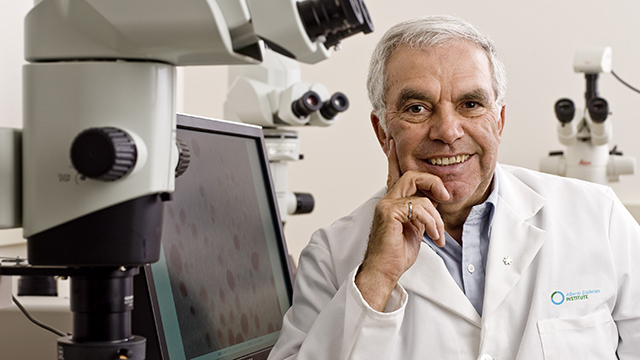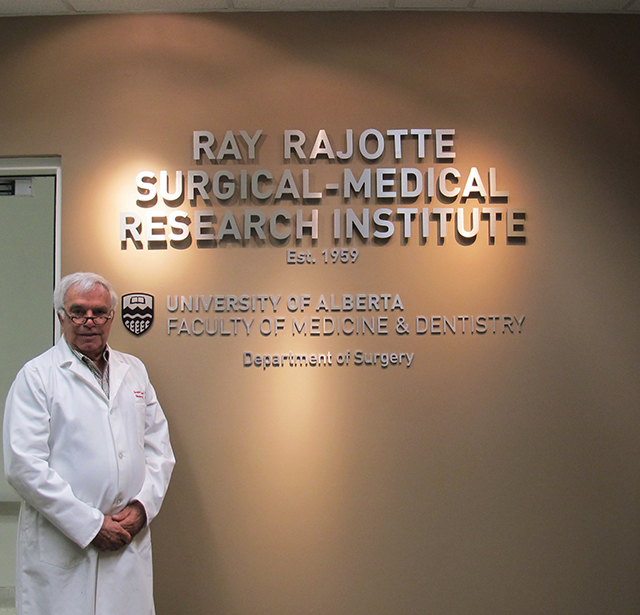
Ray Rajotte
The Surgical Medical Research Institute (SMRI), formed in the 1960s, is the oldest freestanding research institute on the University of Alberta campus but the story of its inception is not what you might expect.
Shortly after Russia launched Sputnik, there was concern around the world that they were going to send a missile to Washington, and on its way over one would fall short of its target and land in Edmonton. Walter C. Mackenzie, the dean of the Faculty of Medicine at the time went to Premier Ernest Manning and convinced him to fund a surgical medical research institute that could be converted to active operating rooms in the event of an emergency.
Then, the Surgical Medical Research Institute was born.
Ray Rajotte started his illustrious career at the U of A in the mid-60s and became director of the SMRI 20 years later. Now located in the Heritage Medical Research Centre and named the Ray Rajotte Surgical Medical Research Institute to honour the former director and leader behind the Edmonton Protocol, the institute continues to spur health care innovation.
The impact of Ray Rajotte
"SMRI has played an incredible, important part of my life and my research life in particular. My first lab was in a bathroom in a basement. Eventually, I moved my research to the ground floor and then became the director," says Rajotte. "It really was an important part of the success of the islet program, I built the islet transplant group there, we built the islet isolation lab, all the work was done in SMRI. I had wonderful support and technical staff that made my job much easier."
The SMRI is where Rajotte developed the islet transplant group that carried out Canada's first islet transplant in 1989 and went on to develop the globally recognized Edmonton Protocol for islet cell transplant in 2000. The islet isolation lab was in SMRI from 1988 to 2000.
In 1999, during Rajotte's tenure as director, it was decided the SMRI needed to be relocated from its original location in the north side of the Dentistry/Pharmacy building. At that time the SMRI provided a lot of research space, including a lot of diabetes-related projects.
"Since there was so much overlap, we decided to build a diabetes institute and inside we were going to put SMRI as a core facility," says Rajotte.
Rajotte took the lead in applying for a Canadian Foundation for Innovation (CFI) grant of $28.5 million and a $10-million pledge from the Alberta Diabetes Foundation for a diabetes institute and the relocation of the SMRI to the Heritage Medical Research Centre. In addition to the SMRI relocation, the funding also allowed for renovation and new equipment.
Using the support from the CFI, the Faculty of Medicine & Dentistry and the departments of Surgery and Medicine, the new facility became a leading-edge surgical facility to train surgeons in the latest techniques such as minimally invasive surgery.
"It's becoming one of the premier surgical training centres in Canada, if not North America," says Rajotte. "We have an incredibly skilled group of technicians in place, and we have an incredible facility with state-of-the-art equipment"
When asked what it means to have the SMRI named after him, Rajotte says he is incredibly pleased.
"I was exceptionally proud and supportive of the projects I oversaw," says Rajotte. "I really encouraged young scientists. When a lot of them started their research, they probably didn't think they were going to become academic surgeons. I tried to show them that research can be challenging and a lot of fun."

Ray Rajotte in the renamed SMRI
History of the SMRI
When SMRI was newly established in 1960, it didn't just provide surgical facilities, but also core facilities for histology, photography and other laboratory services. Rajotte is quick to point out that the institute saw innovative research take place within its walls from the beginning.
J.C. Callaghan, who carried out the first open heart surgery in Canada, did a lot of work in the SMRI on developing an artificial placenta. Peter Allen and J.O. Metcalf worked on creating a dialysis machine at the SMRI and carried out the first dialysis on a patient in Edmonton. The artificial heart prototype that became the Jarvis Heart was developed at the SMRI, in fact a cast of the heart can still be found in the University Hospital.
"The SMRI has always been a catalyst for academic careers," says Rajotte. Surgical residents and fellows began research in the SMRI during their training and often shifted towards careers as physician-researchers. Afterwards, many of them went on to become department chairs across North America-including current dean of Medicine & Dentistry, Richard Fedorak.
Today's Ray Rajotte SMRI
"The SMRI has become the neutral ground for all of Edmonton's hospitals, it's a place where doctors from the different locations can work together," says Rajotte. "We provided the infrastructure for doctors to start their research with minimal barriers."
The SMRI gathers a group of scientists working in different areas of research under one roof, where they can meet regularly at seminars or over lunch. When people encounter problems, they can intermingle and talk to researchers with different expertise to help solve their problems.
At the SMRI, clinical and basic scientists work together to solve clinically relevant problems that are translational.
"The majority of the research carried out in the SMRI is to improve the health of the patient," says Rajotte. "It's not just working in a test tube for the sake of curiosity-driven research, it is translational to see how we can improve the health of the patient."
Rajotte feels the future of the Ray Rajotte SMRI is very bright under the leadership of Gina Rayat, the institute's new director who is one of Rajotte's former graduate students and professor in the Department of Surgery. Though the torch has been passed on, the SMRI's potential for innovation is limitless.
Leading up to World Diabetes Day on November 14, the University of Alberta recognizes the importance of raising awareness about the effects of diabetes on our communities, and the efforts of health professionals to improve patients' lives and find a definitive cure.